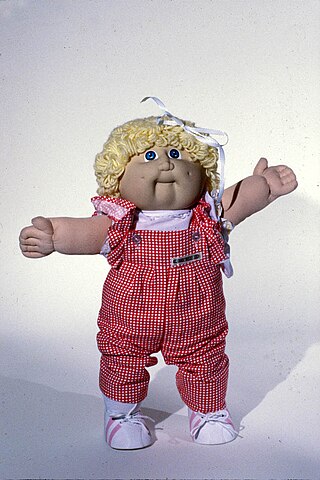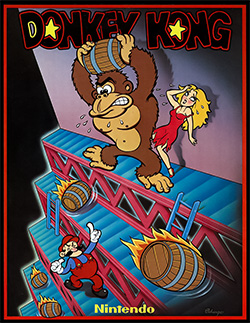Related Research Articles

The Atari 5200 SuperSystem or simply Atari 5200 is a home video game console introduced in 1982 by Atari, Inc. as a higher-end complement for the popular Atari Video Computer System. The VCS was renamed to the Atari 2600 at the time of the 5200's launch. Created to compete with Mattel's Intellivision, the 5200 wound up a direct competitor of ColecoVision shortly after its release. While the Coleco system shipped with the first home version of Nintendo's Donkey Kong, the 5200 included the 1978 arcade game Super Breakout which had already appeared on the Atari 8-bit computers and Atari VCS in 1979 and 1981 respectively.

Coleco Industries, Inc. was an American company founded in 1932 by Maurice Greenberg as The Connecticut Leather Company. It was a successful toy company in the 1980s, mass-producing versions of Cabbage Patch Kids dolls and its video game consoles, the Coleco Telstar dedicated consoles and ColecoVision. While the company ceased operations in 1988 as a result of bankruptcy, the Coleco brand was revived in 2005, and remains active to this day.

ColecoVision is a second-generation home video-game console developed by Coleco and launched in North America in August 1982. It was released a year later in Europe by CBS Electronics as the CBS ColecoVision.
The video game crash of 1983 was a large-scale recession in the video game industry that occurred from 1983 to 1985 in the United States. The crash was attributed to several factors, including market saturation in the number of video game consoles and available games, many of which were of poor quality. Waning interest in console games in favor of personal computers also played a role. Home video game revenue peaked at around $3.2 billion in 1983, then fell to around $100 million by 1985. The crash abruptly ended what is retrospectively considered the second generation of console video gaming in North America. To a lesser extent, the arcade video game market also weakened as the golden age of arcade video games came to an end.

Cabbage Patch Kids are a line of cloth dolls with plastic heads first produced by Coleco Industries in 1982. They were inspired by the Little People soft sculptured dolls sold by Xavier Roberts as collectibles. The brand was renamed 'Cabbage Patch Kids' by Roger L. Schlaifer when he acquired the exclusive worldwide licensing rights in 1982.

The Coleco Adam is a home computer and expansion device for the ColecoVision by American toy and video game manufacturer Coleco. The Adam was an attempt to follow on the success of the company's ColecoVision video game console. It was available as Expansion Module #3 for the ColecoVision, converting it into a home computer, and as a standalone unit. As such, it had the benefit of being entirely compatible with all ColecoVision games and peripherals. The computer came with 64 KB of memory, a tape drive for a proprietary medium called Digital Data Packs, a daisy wheel printer, and productivity applications, along with two DDPs for SmartBASIC and Buck Rogers: Planet of Zoom Super Game. It was released in October 1983 with the initial price of $700.
1983 has seen many sequels and prequels in video games, such as Mario Bros. and Pole Position II, along with new titles such as Astron Belt, Champion Baseball, Dragon's Lair, Elevator Action, Spy Hunter and Track & Field. Major events include the video game crash of 1983 in North America, and the third generation of video game consoles beginning with the launch of Nintendo's Family Computer (Famicom) and Sega's SG-1000 in Japan. The year's highest-grossing video game was Namco's arcade game Pole Position, while the year's best-selling home system was Nintendo's Game & Watch for the third time since 1980.

Donkey Kong Jr. is a 1982 arcade platform game that was released by Nintendo. It is the sequel to Donkey Kong, but with the roles reversed compared to its predecessor: Mario is now the villain and Donkey Kong Jr. is trying to save his kidnapped father. It first released in arcades and, over the course of the decade, was released for a variety of home platforms. The game's title is written out as Donkey Kong Junior in the North American arcade version and various conversions to non-Nintendo systems.

Donkey Kong is a 1981 arcade video game developed and published by Nintendo. As Mario, the player runs and jumps on platforms and climbs ladders to ascend a construction site and rescue Pauline from a giant gorilla, Donkey Kong. It is the first game in the Donkey Kong series and Mario's first appearance in a video game.
The history of video game consoles, both home and handheld, began in the 1970s. The first console that played games on a television set was the 1972 Magnavox Odyssey, first conceived by Ralph H. Baer in 1966. Handheld consoles originated from electro-mechanical games that used mechanical controls and light-emitting diodes (LED) as visual indicators. Handheld electronic games had replaced the mechanical controls with electronic and digital components, and with the introduction of Liquid-crystal display (LCD) to create video-like screens with programmable pixels, systems like the Microvision and the Game & Watch became the first handheld video game consoles.
1982 was the peak year for the golden age of arcade video games as well as the second generation of video game consoles. Many games were released that would spawn franchises, or at least sequels, including Dig Dug, Pole Position, Mr. Do!, Zaxxon, Q*bert, Time Pilot and Pitfall! The year's highest-grossing video game was Namco's arcade game Pac-Man, for the third year in a row, while the year's best-selling home system was the Atari 2600. Additional video game consoles added to a crowded market, notably the ColecoVision and Atari 5200. Troubles at Atari late in the year triggered the video game crash of 1983.

Mr. Do! is a 1982 maze video game developed by Universal. It is the first arcade video game to be released as a conversion kit for other cabinets; Taito published the conversion kit in Japan. The game was inspired by Namco's Dig Dug released earlier in 1982. Mr. Do! was a commercial success in Japan and North America, selling 30,000 arcade units in the US, and it was followed by several arcade sequels.
In the history of video games, the second-generation era refers to computer and video games, video game consoles, and handheld video game consoles available from 1976 to 1992. Notable platforms of the second generation include the Fairchild Channel F, Atari 2600, Intellivision, Odyssey 2, and ColecoVision. The generation began in November 1976 with the release of the Fairchild Channel F. This was followed by the Atari 2600 in 1977, Magnavox Odyssey² in 1978, Intellivision in 1980 and then the Emerson Arcadia 2001, ColecoVision, Atari 5200, and Vectrex, all in 1982. By the end of the era, there were over 15 different consoles. It coincided with, and was partly fuelled by, the golden age of arcade video games. This peak era of popularity and innovation for the medium resulted in many games for second generation home consoles being ports of arcade games. Space Invaders, the first "killer app" arcade game to be ported, was released in 1980 for the Atari 2600, though earlier Atari-published arcade games were ported to the 2600 previously. Coleco packaged Nintendo's Donkey Kong with the ColecoVision when it was released in August 1982.
In the history of video games, the first generation era refers to the video games, video game consoles, and handheld video game consoles available from 1972 to 1983. Notable consoles of the first generation include the Odyssey series, the Atari Home Pong, the Coleco Telstar series and the Color TV-Game series. The generation ended with the Computer TV-Game in 1980 and its following discontinuation in 1983, but many manufacturers had left the market prior due to the market decline in the year of 1978 and the start of the second generation of video game consoles.

Atari, Inc. was an American video game developer and home computer company founded in 1972 by Nolan Bushnell and Ted Dabney. Atari was a key player in the formation of the video arcade and video game industry.
The 1980s was the second decade in the industry's history. It was a decade of highs and lows for video games. The decade began amidst a boom in the arcade video game business with the golden age of arcade video games, the Atari 2600's dominance of the home console market during the second generation of video game consoles, and the rising influence of home computers. However, an oversatuation of low quality games led to an implosion of the video game market that nearly destroyed the industry in North America. Most investors believed video games to be a fad that had since passed, up until Nintendo's success with its Nintendo Entertainment System revived interest in game consoles and led to a recovery of the home video game industry. In the remaining years of the decade, Sega ignites a console war with Nintendo, developers that had been affected by the crash experimented with PC games, and Nintendo released the Game Boy, which would become the best-selling handheld gaming device for the next two decades. Other consoles released in the decade included the Intellivision, ColecoVision, TurboGrafx-16 and Sega Genesis.
Sente Technologies was an arcade game company. Founded as Videa in 1982 by several ex-Atari employees, the company was bought by Nolan Bushnell and made a division of his Pizza Time Theatre company in 1983. In 1984 the division was acquired by Bally Midway who continued to operate it until closing it down in 1988. The name Sente, like Atari, is another reference to Bushnell's favorite game, Go and means "having the initiative."

In the video game industry, the market for home video game consoles has frequently been segmented into generations, grouping consoles that are considered to have shared in a competitive marketspace. Since the first home consoles in 1972, there have been nine defined home console generations.

Looping is an action game developed and published in arcades in 1982 by Video Games GmbH in Europe and Venture Line in North America. The player controls a plane across two phases in order to reach a docking station by destroying a terminal base or a rocket base to open a gate while avoiding obstacles along the way.
References
- De Maria, Rusel; Wilson, Johnny L. (2004). High Score!: The Illustrated History of Electronic Games (2nd ed.). New York: McGraw-Hill/Osborne.
- Kent, Steven L. (2001). The Ultimate History of Video Games: The Story behind the Craze that Touched Our Lives and Changed the World . New York City: Three Rivers Press.